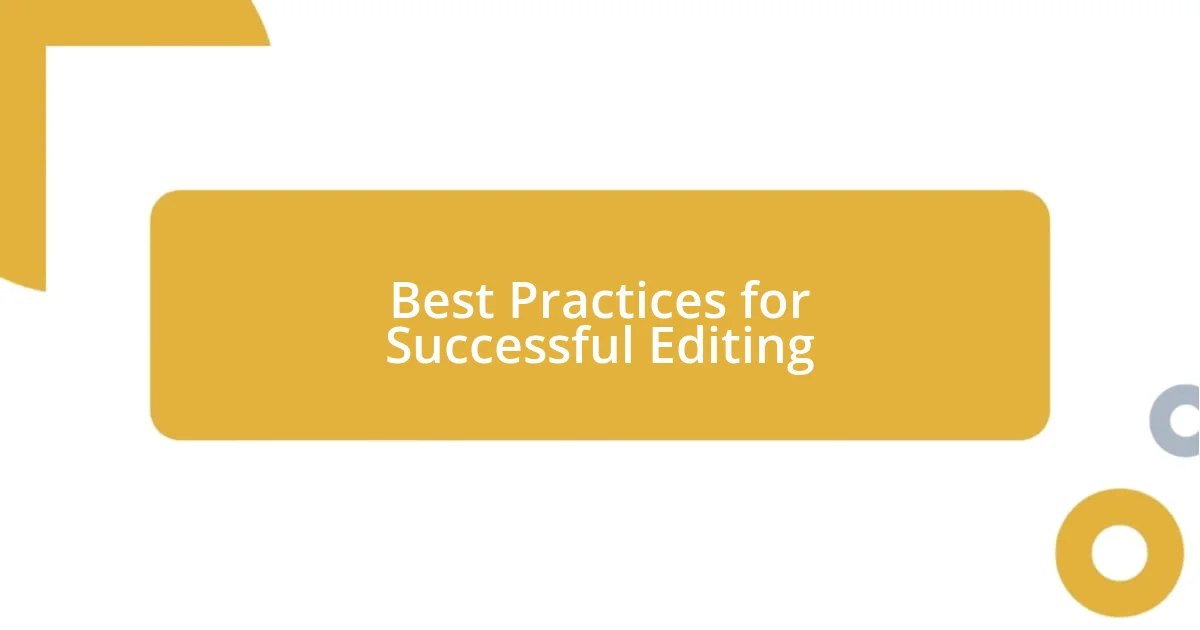Key takeaways:
- The introduction of CRISPR has revolutionized gene editing, raising both excitement and ethical concerns about altering life.
- In practical experiences, witnessing CRISPR’s application and discussing “designer babies” highlighted the profound responsibility that comes with gene editing advancements.
- Best practices in gene editing emphasize meticulous planning, flexibility, and collaboration to overcome setbacks and enhance successful outcomes.

Understanding Gene Editing Techniques
Gene editing techniques, particularly CRISPR, have revolutionized the way we think about genetics. I remember the first time I heard about CRISPR—it felt like a scene straight out of a sci-fi novel. The ability to target specific genes and make precise edits stirred a mix of fascination and a bit of fear in me. Can you imagine rewriting the genetic code of an organism with such precision? It’s both empowering and daunting.
Beyond CRISPR, there are older methods like TALENs and ZFNs that have paved the way for these advancements. Each technique has its pros and cons; for instance, while TALENs are effective, they can be more cumbersome to design than CRISPR. I still find myself wondering, how do researchers choose which technique to use? In my experience, it often comes down to the specific goals of the research and the organisms involved.
When I delve into the world of gene editing, I can’t help but be intrigued by the potential ethical dilemmas too. What does it mean to have the power to alter life? I think of the stories about scientists cautiously celebrating breakthroughs, knowing full well that these advancements could lead to significant changes in nature and medicine. It’s a balancing act, one that requires a deep understanding of the technology and its implications.

Personal Experiences with Gene Editing
In my journey with gene editing, I recall my initial lab experience where I witnessed CRISPR in action for the first time. The excitement in the room was palpable as researchers introduced targeted edits into plant DNA. I felt a sense of awe at how a simple tweak could potentially yield crops resistant to diseases. It really hit me then—this technology could change the very fabric of our food supply.
Another striking moment for me occurred during a lecture on the ethical implications of genome editing. I remember a poignant discussion about “designer babies.” The thought of using gene editing to choose traits really sent chills down my spine. It dawned on me that with such power comes immense responsibility. How do we ensure fairness in access to this technology? I believe that ongoing conversations about ethics in gene editing are just as crucial as the science itself.
I also had the chance to collaborate on a project focused on gene therapies for rare genetic disorders. The hope in the families we worked with was inspiring. They saw in us a glimmer of change, a potential cure. This experience solidified my belief in gene editing’s transformative power but also reminded me of the human element behind the science. It’s not just about the technology; it’s about the lives it can touch.
| Experience | Emotional Insight |
|---|---|
| First exposure to CRISPR | Awe at the technology’s potential |
| Discussion on designer babies | Chills about ethical implications |
| Collaboration on gene therapies | Hope from families for a better future |

Best Practices for Successful Editing
In my experience, adopting best practices in gene editing involves a mix of meticulous planning and flexibility. I’ve learned that having a well-defined protocol can make all the difference. For instance, during one of my projects, we spent weeks refining our experimental design, only to pivot mid-way when unexpected results emerged. Embracing this adaptability fostered creativity in our strategies, ultimately leading to successful outcomes.
Here are some best practices I’ve found invaluable:
- Thoroughly research your target: Understanding the gene’s function and its interactions with other elements can guide your edits effectively.
- Use control samples: They help verify that changes are due to your editing and not other variables.
- Incorporate robust validation: Confirming the accuracy of your edits through sequencing is crucial to avoid unexpected mutations.
- Keep clear records: Document every step of the process, including failures; they often hold the key to future successes.
- Engage in discussions: Collaborating with colleagues can spark perspectives that lead to creative solutions or new methodologies.
The emotional journey is just as crucial as the scientific one. I recall when my team faced a significant setback due to an unforeseen off-target effect. The initial frustration was palpable, but it eventually transformed into a learning moment. We rallied together, analyzing the data, and that shared experience truly bonded us. It was a vivid reminder that setbacks are part of the process, often paving the way to deeper insights and stronger teamwork.

Overcoming Common Gene Editing Challenges
Overcoming common challenges in gene editing often calls for creative problem-solving and resilience. One of my most daunting experiences occurred during a project targeting a particularly tricky gene. After multiple unsuccessful attempts, I remember sitting down with my colleagues, hashing out the issues over coffee. That collaborative environment sparked new ideas, including tweaking our delivery method. This realization hit home: sometimes, the best solutions come when you least expect them and rely on the collective knowledge of your team.
Another memorable hurdle was off-target effects, those pesky unintentional edits that can derail a project. I once faced such an issue while working on editing a gene linked to a rare condition. The initial wave of frustration left me feeling discouraged. However, I decided to turn that frustration into motivation. I dove deep into the data and discovered an alternative approach that minimized these risks. The process taught me that setbacks often serve as vital learning moments, pushing us to refine our techniques and think outside the box.
On a more technical note, ensuring precision is essential in gene editing. One technique that I’ve found effective involves dual-guide RNA systems, which enhance targeting accuracy. By harnessing this approach, I witnessed a significant reduction in off-target effects during my experiments. It made me wonder: how often do we miss out on breakthroughs simply because we don’t explore advanced methodologies? For me, this realization underscored the importance of staying informed about evolving techniques. Embracing innovative tools brings us closer to the goal of maximizing gene editing’s potential while minimizing risks.














